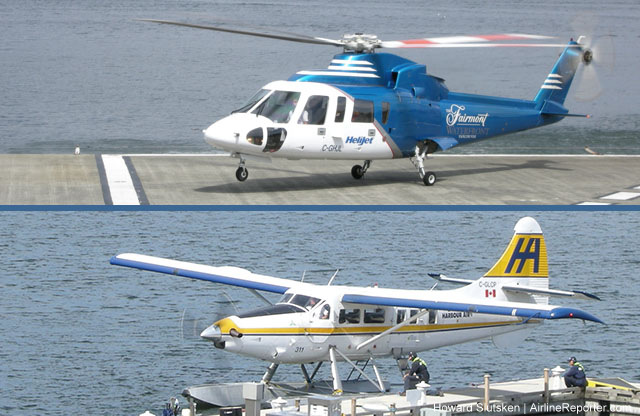
Helijet Sikorsky S-76 & Harbour Air DHC-3 Turbine Otter
In the early 2000s I lived in beautiful Victoria, British Columbia, about as far west in Canada as you can be without falling into the Pacific Ocean. Victoria is at the most southern tip of 460 km (290 mile) long Vancouver Island, about even with Whidbey Island, Washington. Business would take me to downtown Vancouver regularly, a straight-line distance of about 110 km (70 miles). I could drive to the ferry terminal, wait, have a nice 90 minute ferry ride, then drive in traffic to downtown Vancouver. Total trip time? 3 hours, if traffic was light. Cost? About CA$70 each way. But I could also fly harbour to harbour in about 30 minutes. As a fellow AvGeek, which one do you think I enjoyed more??
There are 2 regular airline services flying between Victoria’s and Vancouver’s harbours. Both harbours are Transport Canada certified airports, with designated water ’œrunways’. You can fly fixed-wing on Harbour Air’s 14 passenger DeHavilland Canada DHC-3 Turbine Otters or 18-seat DHC-6 Twin Otters. Or you can take a helicopter – Helijet flies 12-seat, twin-engine, Sikorsky S-76s or 4-seat Bell 206L LongRangers. Which way to go? Let’s have a look at the two airlines.
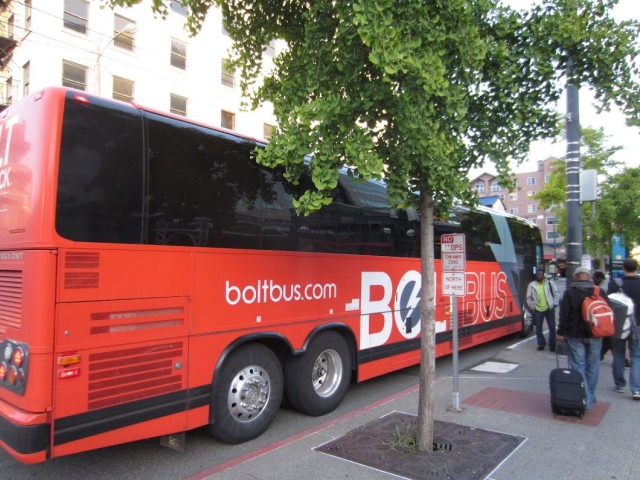
Catching the Bolt Bus in Seattle, WA. Photo by Malcolm Muir.
This is a guest post written by Malcolm Muir for AirlineReporter.com. Here is his experience with Bolt Bus in his own words (note: Malcom paid his own way there and back) …
A last minute trip north to Vancouver gave me the opportunity (and an excuse) to try out Bolt Bus. Bolt is a new entrant to the Pacific Northwest market and started operations late May. Bolt is owned and operated by Greyhound and from stories I had heard about service etc. from Greyhound I was a little apprehensive.
Costs were extremely good. A one way ticket method cost the day before departure was only $33 round trip (including the $1 booking fee). This was for a late Friday evening departure and mid-Sundays afternoon return so prime services. Like the airlines, fares can vary depending on the time of day as an earlier return from Vancouver would have saved around $10. Fares start at $1 with Bolt Bus so if you can get in early enough with the booking fee could be $3 round trip.
The boarding passes/booking confirmation is emailed and/or texted to you immediately and you’re set. Bolt Bus boards by groups similar to airline zones (unsure how they are assigned though as I was given Group A for both tickets) which helps to ensure that people won’t just rush the bus when it arrives.
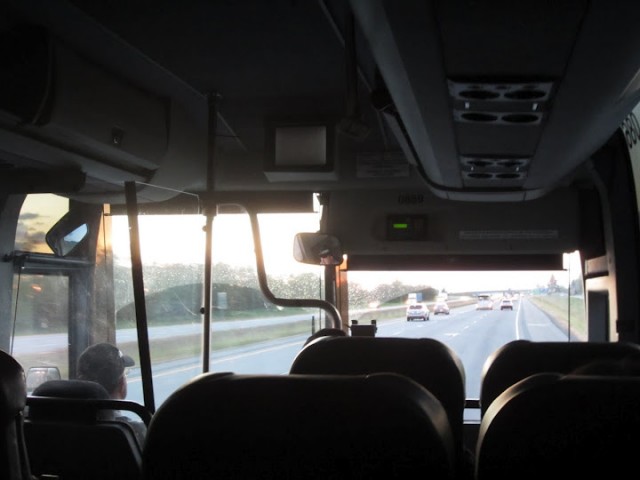
Photo by.
Seattle is the middle point for journeys in either direction so there could be delays that hold up the bus (such as traffic in heavy times) however my bus arrived from Portland about 10 minutes prior to its scheduled departure to Vancouver.
Unfortunately, there currently isn’t any signage at the Seattle departure point (5th Ave S & King Street, the International District bus station) so there were many people milling about with worried looks on their faces asking “does Bolt Bus go from here?”
The buses are all modern looking, with leather seated interiors, more seat pitch compared to the competitors, and power points at each row (mounted to the row in front, so avoid the first row as none fitted). Free Wi-Fi is offered inboard however it only works as far as the Border crossing as they don’t seem to have coverage in Canada.
One downside of the seat is the lack of a tray table. There is ample room for it to fit and would definitely make working with a laptop easier but it’s not a deal breaker.
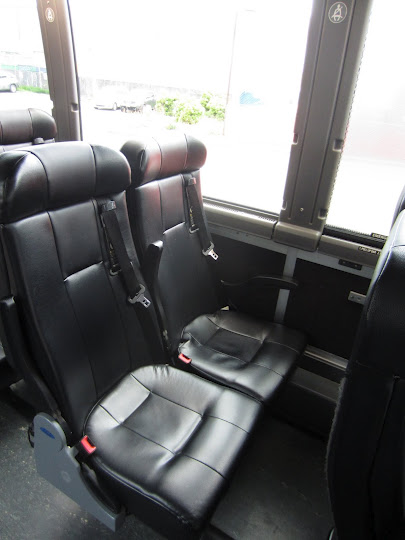
Photo by.
Both trips were lightly loaded, so a set of two seats to myself allowed me to spread out the gear and get some work done. Heading north, the traffic was light and the 8pm departure time avoids most of the I5 traffic snarls of an afternoon. We departed a few minutes late out of Seattle, but this, again, is not a deal breaker.
Bolt Bus allows 2 hours from Seattle north to the border, 30 minutes for the border crossing and another hour into Vancouver, ample time in the 2 hours to catch him up and also relax into the weekend.
The border crossing heading north was uneventful other than having ingredients to wait for 5 minutes while they found some staff, a few questions and I was stamped into Canada. The continued journey resumed right at the 30 minute mark (they leave once everyone is processed so this is where scheduled time could take a hit) and completed the journey into Vancouver in the allotted 1 hour.
Since there is no food service and no stops between Seattle and Vancouver, you need to bring it with you. I took stuff with me on the bus and had no problems, however be mindful of the border crossing as some foods can’t go over (saw a lady have to bin an apple at US customs). The Seattle stop is a good location to pick up some food as it’s right next to Uwijamaya for some good Japanese/Asian food and drinks at non airport pricing.
There is a bathroom on board the bus, but luckily I did not end up having to use it.
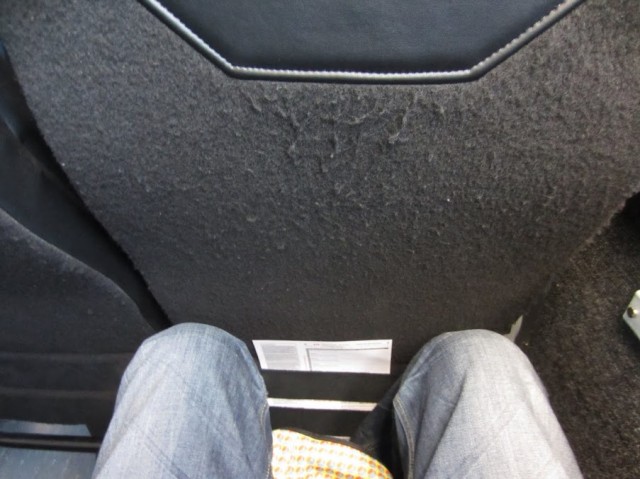
Okay legroom, but no tray table on the Bolt Bus.
We arrived into a deserted Pacific Central at 1135pm and it is a bit nerve racking to not see any cabs at the terminal but I am sure this will be against changed in the long run once Bolt have been up and running longer.
The journey south was even more painless as there was an extremely light load. The driver separated the boarding groups to control the group easier but in this instance probably was not needed as much. Traffic was very light for a Sunday afternoon and we made the border early and with customs & immigration taking only 15 minutes for the load we were back on the road early.
After an amazing sight returning to Seattle with a blue sky and a magnificent view of Mt Rainer from I5 we actually arrived 30 mins early. A smooth painless journey in either direction.
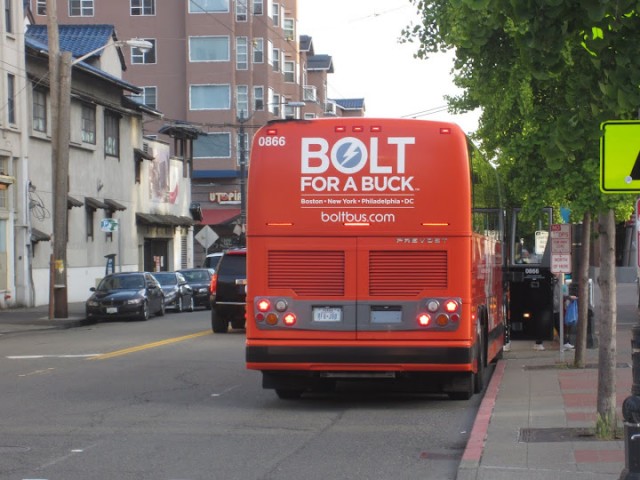
And back to Seattle on the Bolt Bus.
The journey with Bolt Bus was definitely an easy one, from the simple booking process to the journey itself, more reminiscent of an ultra-express service as no stops are made between cities. A couple of issues do need to be addressed such as connectivity across the border and signage at departure points; however for the price it’s not that big of an issue.
Bolt Bus favors highly over the direct competitors such as Greyhound and Quick bus. But there would be good competition from Amtrak. With Bolt Bus, if loads are light border crossings would be much quicker than Amtrak as they do not have to work through an entire training load of people, however Amtrak is not at the mercy of traffic problems so if a journey was made during the prime peak hour times, this could obviously add significant delays.
Compared to flying though the price is definitely a big difference as a last minute return with Air Canada was pricing in at $600 return for Best Available fare. Amtrak fares were around $100 return.
If you can get the fares for as little as $1 each way, then Bolt bus is definitely a fantastic option and can only improve as the service gets a bit more popular and has time to be able to settle into the PNW market.

Inside YVR.
For some this might not seem like a prize for a contest, but for many who love the airline business, this is a once in a lifetime opportunity. Vancouver International Airport (YVR) is holding a contest, where the winner will live in YVR for 80 days.
Do not worry, you won’t have to sleep there – a nice free room awaits you in a hotel, but during the day time hours, you are on. There will be no “average day” during your 80-day stint. “Each day, he/she will be shooting a story, editing it and posting it to the Live@YVR site,” Rebecca Catley, Director of Communications for the airport explained via email. “They will be meeting people, researching stories, socializing with YVR employees, and checking out all the airport has to offer. They will be using Twitter and Facebook, writing a daily blog, and some days, turning the camera on themselves as part of their video diary. There will be lots they will want and need to do and lots for them to explore.”
The idea is to show how YVR is a city with-in a city. Many passengers just see the airport as one unwelcome step to the travel experience, but they can be part of the experience. There are over 23,000 employees and 400 businesses at the YVR to explore, which is similar to many other airports.
Now, the biggest restriction for the contest is you must be a British Columbia resident, but you do not need to be a Canadian citizen. Probably one of the strictist requirements, according to their site, is you must be “generally awesome,” a very important quality. If you meet the requirements and have a great idea, post your video to their contest page and good luck!
Image: roaming-the-planet






